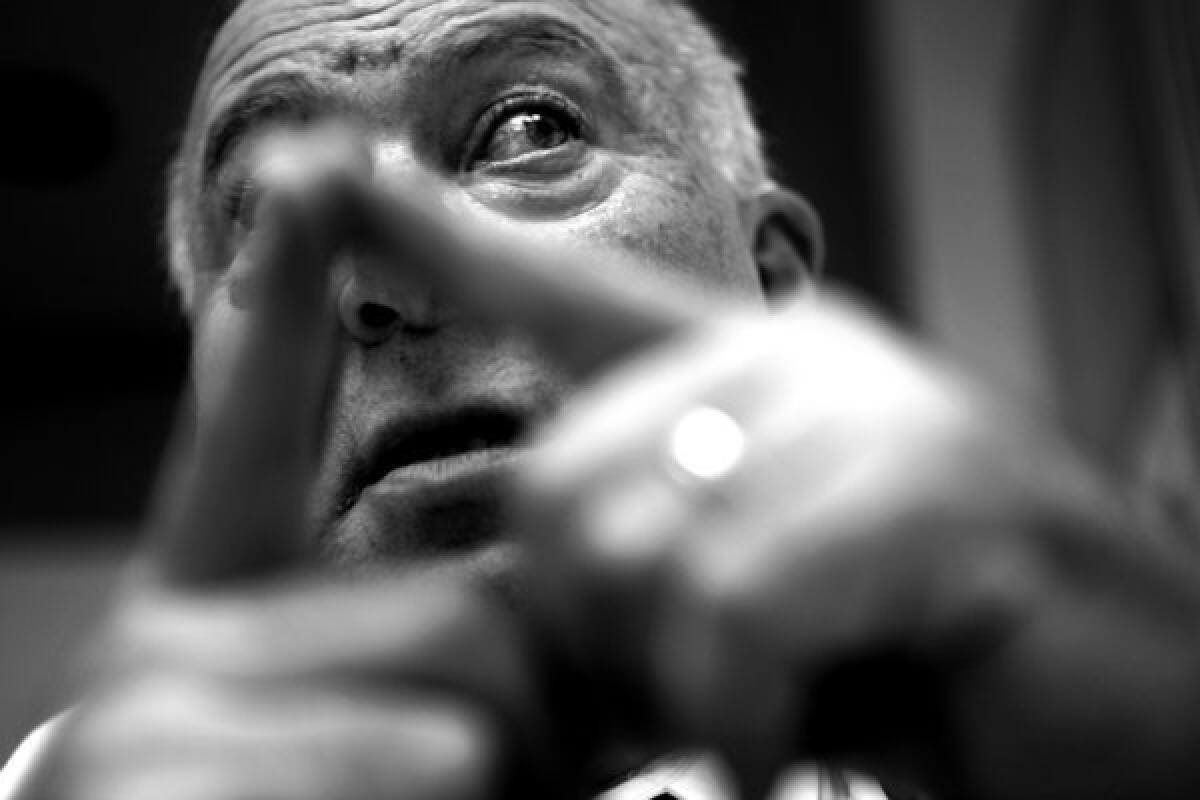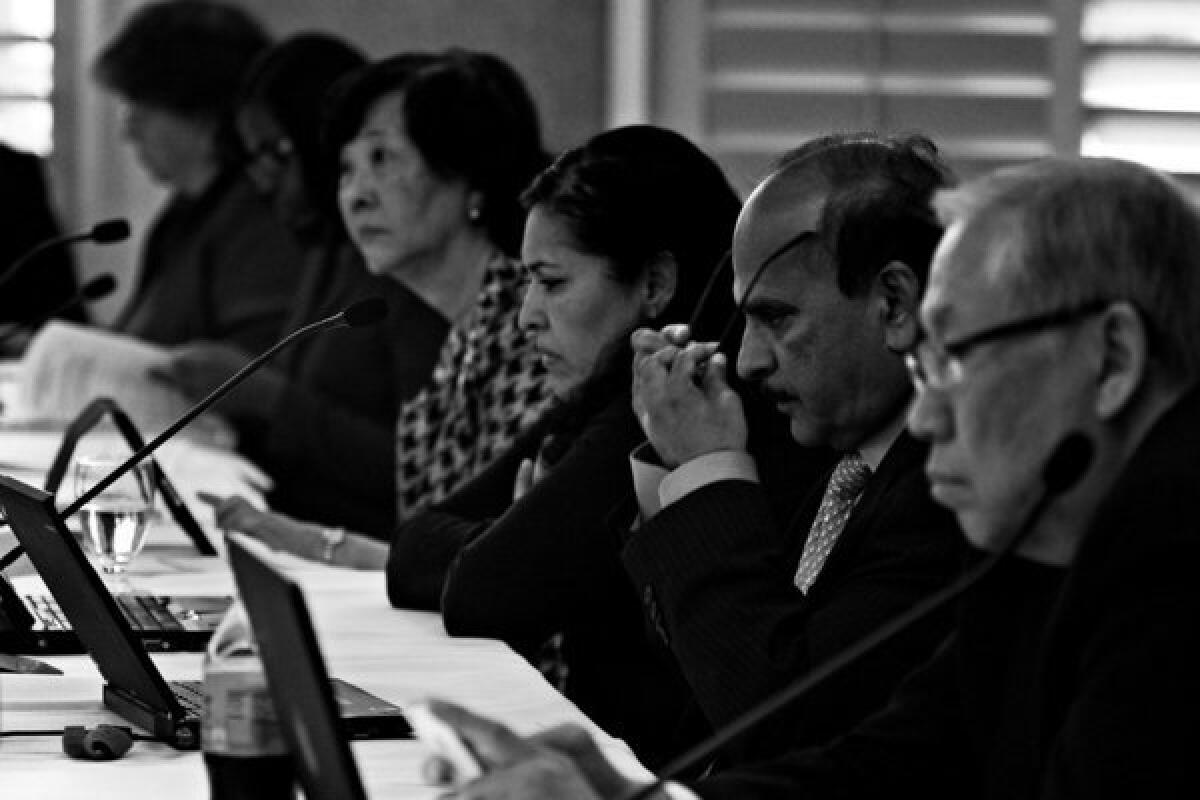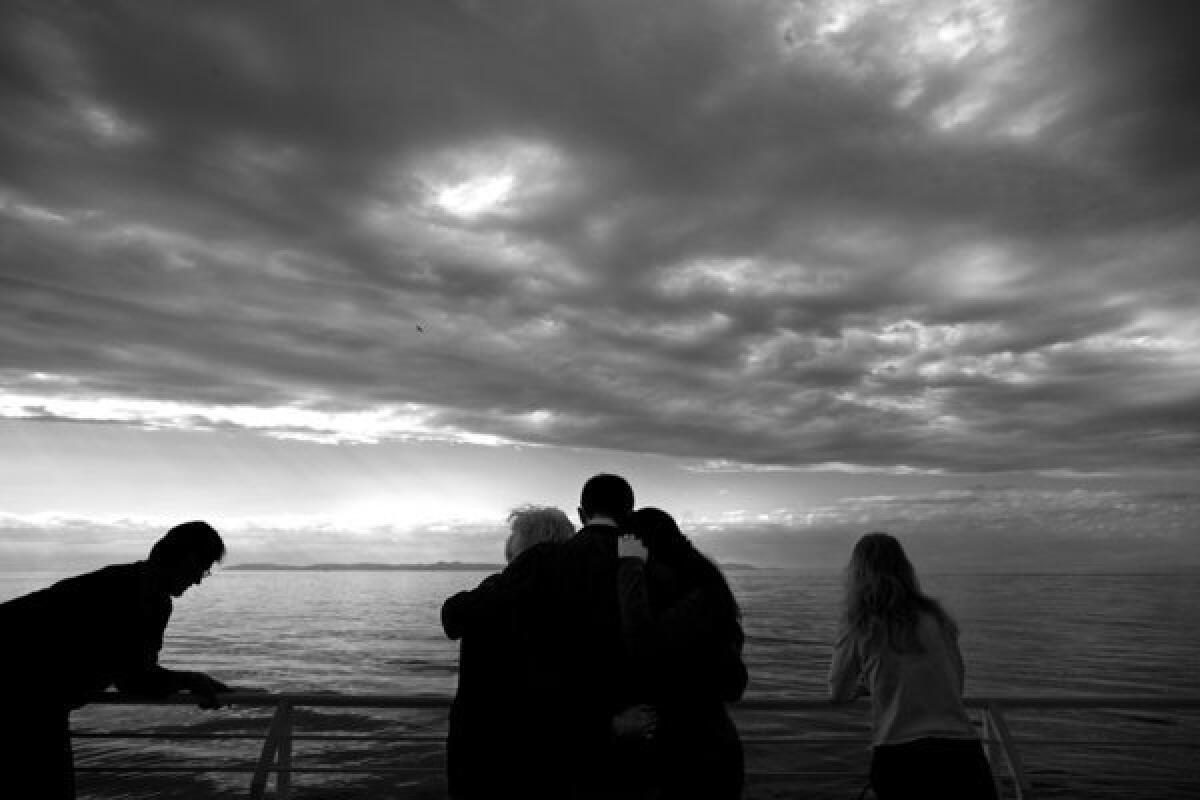Reckless prescribing, lost lives
The Medical Board of California is often slow to act when investigating doctors suspected of abusing their prescription pads - even when patients are dying.
- Share via

Dying for relief | A Times Investigation
Dr. Carlos Estiandan was up to no good, and the Medical Board of California was on to him.
December 9, 2012

He prescribed powerful painkillers to addicts who had no medical need for them, conducted sham examinations and appeared to be a key supplier for drug dealers, according to court records.
He wrote more prescriptions than the entire staffs of some hospitals and took in more than $1 million a year.
Worse, one of Estiandan's patients had fatally overdosed on drugs he prescribed, a board investigator learned. The investigator said in her report that she confronted the doctor and told him the death was "the inevitable result" of giving narcotics to an addict.
Unknown to the investigator, two other Estiandan patients had suffered fatal overdoses. More deaths would follow.
By the time the medical board stopped Estiandan from prescribing, more than four years after it began investigating, eight of his patients had died of overdoses or related causes, according to coroners' records.
It was not an isolated case of futility by California's medical regulators. The board has repeatedly failed to protect patients from reckless prescribing by doctors, a Los Angeles Times investigation found.
It is board policy to give such cases a high priority. But The Times' examination of board records and county coroners' files from 2005 through 2011 found that:

"Material things are nothing now," said Dr. Carlos Estiandan, who was released from prison in September, after serving roughly half of a five-year sentence. (Liz O. Baylen / Los Angeles Times)
- At least 30 patients in Southern California have died of drug overdoses or related causes while their doctors were under investigation for reckless prescribing. The board ultimately sanctioned all but one of those 12 doctors, and some were criminally charged — too late to prevent the deaths.
- The board seldom tries to suspend the prescribing privileges of doctors under investigation. The agency can petition a judge for an interim suspension order. It has obtained orders only rarely: 12 times in the last five years in cases of excessive prescribing, in a state with more than 100,000 practicing physicians.
- Even when the board sanctions doctors for abusing their prescribing powers, in most cases it allows them to continue practicing and prescribing. In 80% of the 190 cases of improper prescribing filed by the board since 2005, the offending physician was given a reprimand or placed on probation. In most of those cases, the doctor was allowed to continue writing prescriptions with few or no restrictions.
- Eight doctors disciplined for excessive prescribing later had patients die of overdoses or related causes. Prescriptions those doctors wrote caused or contributed to 19 deaths.
At the heart of these shortcomings is the board's approach to oversight. It investigates when it receives a complaint of abuse or poor treatment of a specific patient or patients. It generally does not look for evidence of wider problems in a physician's practice.
Voices

Dose of Reality
After a debilitating prescription drug overdose, Aaron Rubin warns audiences about the dangers of drug abuse.

Pills For Life
Injuries he suffered as a stuntman and in an auto accident left John Jackson dependent on prescription narcotics.

Another Day Without Alex
Their son's 2008 prescription drug overdose death is a painful legacy for Ron and Arline Clyburn.

Bitter Pills
In rehab, Edward Shut fights his addiction to prescription drugs.
For example, in looking into cases of improper prescribing, investigators usually do not search county coroners' files to determine whether — as in Estiandan's case — a doctor's patients are dying of drug overdoses.
Dr. Rick Chavez, a pain management physician in Redondo Beach, serves as an expert for the board in cases of reckless prescribing. He said overprescribing is a pervasive problem, and oversight is inadequate.
"We have doctors out there doing things that no one is monitoring," he said. "It's scary."
The medical board's president, Sharon Levine, a pediatrician who is an executive at Kaiser Permanente, declined to be interviewed, saying it would be "inappropriate" because disciplinary cases are ultimately decided by the board. Executive Director Linda Whitney declined to comment, and staff members said they are barred by policy from speaking with reporters.
Responding by email to written questions, board officials asserted that their "highest priority and primary mission is consumer protection."
In response to The Times' findings, they have asked the Legislature to require county coroners to report all prescription drug deaths to the board.
"If only one physician was found to be overprescribing," the board said in its request to legislators, "this could save numerous lives."

Estiandan, a diminutive man with a cheerful demeanor, had a thriving general practice. He sang tenor in his church choir, played golf once a week with his sons and took his wife ballroom dancing. He was a lieutenant colonel in the U.S. Air Force Reserve and led medical relief missions to the Philippines, where he grew up and attended medical school.
In October 2004, one of his employees reached out anonymously to authorities.
The man told Robin Hollis, a medical board investigator, that Estiandan, then 62, was taking in $3,000 in cash a day selling prescriptions. Drug-addicted patients, the employee said, crowded the lobby of the doctor's clinic west of downtown Los Angeles, one of three he owned.
"Estiandan will give the patients anything they want," he told Hollis, according to her report.
The U.S. Drug Enforcement Administration and the Los Angeles County Sheriff's Department were also investigating Estiandan, and the agencies shared information.
Evidence accumulated quickly. Alleged drug dealers were arrested in Los Angeles carrying bottles of medications prescribed by Estiandan, court records show.
A Costco pharmacist reported that groups of men in their 20s and 30s were showing up at his counter with prescriptions from Estiandan for painkillers, tranquilizers and muscle relaxants — the makings of a drug cocktail that is popular with addicts.
The pharmacist, Edward Wong, told authorities he would call Estiandan to make sure the prescriptions were legitimate, and the doctor would instruct him to fill them. Eventually, Wong stopped calling and simply refused to fill the prescriptions.
In Albuquerque, DEA agents stopped a man who was carrying more than 1,800 pills and several bottles of narcotic cough syrup with a street value of up to $500 each. According to court records, the medication labels identified Estiandan as the prescriber.
In the summer of 2005, about 10 months into the investigation, Leo Martinez checked in at Estiandan's clinic in Reseda. He paid a $120 fee for the office visit and waited a half-hour to see the doctor.
What happened next is detailed in court records.
Estiandan asked Martinez what was wrong.
"Nothing," Martinez said. He explained that he wanted a refill for painkillers he had been prescribed by another doctor whose clinic had since closed.
Estiandan asked him why he was in pain: Had he fallen or been in an accident?
No, Martinez replied.
He asked Martinez again if he had hurt his back or been in an accident. This time, Estiandan nodded and raised his eyebrows.
Estiandan said the other doctor must have had a reason to prescribe painkillers.
Martinez said it was a long time ago and he couldn't remember.
Estiandan told Martinez he couldn't prescribe the drugs unless there was an indication Martinez was in pain.
Then he asked Martinez again if he had hurt his back or been in an accident. This time, Estiandan nodded and raised his eyebrows.
Reading the cue, Martinez said he hurt his back lifting weights.
Estiandan pulled out his prescription pad.
Martinez was an undercover sheriff's narcotics investigator who had been secretly recording the conversation. He left Estiandan's office with prescriptions for the painkiller Vicodin, the muscle relaxant Soma, the anti-anxiety drug Valium and a 16-ounce bottle of narcotic cough syrup.
The medical board and law enforcement agencies were not the only ones interested in Estiandan.

Feeble Safeguards The cases of two doctors accused of excessive prescribing show how the medical board struggles and sometimes fails to protect patients. More photos »
»
Medi-Cal agents suspected him of fraudulent billing and put him under surveillance. They followed him as he drove home to Northridge in a Lincoln Navigator or Lexus sedan, sometimes stopping at a hospital or to pick up takeout at a Filipino restaurant.
But amid this intense scrutiny of Estiandan's life and medical practice, one thing appears to have escaped attention: what was happening to his patients.
One of them, Pamela Stone, suffered chronic pain from herniated disks. She also struggled with anxiety and had trouble sleeping.
Stone's mother grew concerned when she didn't hear from her daughter for a couple of days and asked the manager of the Reseda apartment building where Stone lived to check on her.
On Nov. 20, 2006, the manager opened the door to the apartment and found Stone's lifeless body on her bed. There was a trace of dried white foam around her nose and mouth.
The coroner determined that Stone died of an accidental overdose of multiple drugs, including an anti-anxiety medication prescribed by Estiandan. She was 54.
Hollis continued with her investigation, unaware of the death.

Hollis is one of about 130 medical board investigators on the front lines of patient protection in California. They look into allegations of physician misconduct ranging from botched surgeries to sexual abuse of patients.
Their ranks have dwindled, even as the number of licensed physicians in the state has risen over the last decade, to 102,000.
There are about 30 fewer investigators today than in 2001. The board opened 1,577 investigations last year, a 40% decline from a decade ago, and investigations now take longer to complete: an average of 347 days, compared with 256 in 2001.
The agency is overseen by a 15-member board appointed by the governor and legislative leaders. By law, eight members must be doctors. The board is funded by physician licensing fees, a revenue stream that was supposed to be immune to California's boom-and-bust budget cycles.

Members of the Medical Board of California meet in Torrance in May. (Liz O. Baylen / Los Angeles Times)
But Govs. Arnold Schwarzenegger and Jerry Brown used the board as a piggy bank, taking $15 million in licensing fees — the equivalent of a quarter of one year's budget — to help fill holes in the state general fund.
Schwarzenegger ordered state employees to take three unpaid furlough days per month, hobbling the board's enforcement efforts. Brown imposed hiring freezes. At one point, 1 in 4 investigator positions were vacant.
The board's staff has warned for years that the cuts were crippling its ability to protect the public. Julianne D'Angelo Fellmeth, a public interest lawyer who has monitored the board for the state Legislature, said the situation is urgent.
"The medical board is regulating the most important profession in terms of irreparable harm," Fellmeth said. "It should not be neutered."
The board's challenges go beyond the financial. Unlike medical regulators in other states, it cannot suspend a doctor's license or prescribing privileges on its own, even to prevent imminent harm.
Instead, the board must petition a state administrative law judge for an interim suspension order. If it obtains an order, the board must file a complaint against the doctor within 15 days — a legal provision for which physician groups lobbied, Fellmeth said.
The 15-day rule means that "an investigation must be nearly complete" before the agency can seek a suspension, board spokeswoman Jennifer Simoes wrote in an email.
If a doctor has been criminally charged, the board can ask a Superior Court judge for a suspension. It has done so a handful of times in recent years in cases of excessive prescribing.
Board officials said they sometimes hold off on seeking suspensions until that point to avoid jeopardizing a criminal investigation.
Steve Opferman, a Los Angeles County sheriff's deputy who runs a task force on healthcare fraud and took part in the Estiandan investigation, questioned that rationale. He said the board should move swiftly to shut down a doctor's prescribing whenever lives are at stake — even if it could affect a criminal prosecution.
The danger in waiting, he said, is that "people are going to die."

Andrew Corless began abusing drugs at the age of 15 and spent at least eight stints in drug treatment. On Aug. 11, 2006, he had a moment of resolve.
He called Estiandan's office at 11:45 a.m. that day and left a message.
He was about to undergo drug detoxification, according to a handwritten note by a receptionist, and he asked that the doctor "please not see him anymore."
Three hours later, Corless called back with a message "to disregard" the earlier call.

Leslie Greenberg lies in the grass at a park after leaving flowers at the nearby grave of her boyfriend Andrew Corless, who died in 2006 of prescription drug and alcohol intoxication. (Liz O. Baylen / Los Angeles Times)
Corless was in Estiandan's office 10 days later, pleading for drugs, court records show. He was back again in December, this time after leaving rehab early.
On Dec. 13, 2006, Corless, 46, was found on the street in front of his house in Northridge, dead of an overdose. Two of the drugs found in his system — hydrocodone and alprazolam — had been prescribed for him by Estiandan.
A month later, authorities searched Estiandan's offices and home. They found hundreds of partially completed prescription forms, some of them already signed, along with $12,300 in cash, court records show.
Looking at patients' records, investigators saw that groups of people from as far as Bakersfield, the Antelope Valley, Victorville and San Bernardino would show up at Estiandan's clinic near downtown Los Angeles on the same day, describe the same symptoms and leave with prescriptions for the same drugs.
Shortly after the raid, Estiandan was back at work — and writing prescriptions at a furious pace.
DEA agents consulted a database on prescriptions for controlled substances, written for patients paying in cash, to see where Estiandan stood. For March 2007, he ranked first in Southern California, Nevada and Hawaii, and fifth in the United States, according to court records.
For Joyce Saldivar, 55, he prescribed hydrocodone.
Saldivar had chronic back pain and was known to abuse her medications, according to coroner's records. She died June 29, 2007. The cause was an overdose of multiple drugs, including hydrocodone.
Estiandan acknowledged that Corless was an alcoholic and an addict and had “begged” him for drugs, according to Hollis' report.
By then, Hollis had learned about Corless' death from his girlfriend, who complained to the medical board about Estiandan, court records show.
Hollis got Corless' medical records and the autopsy report, and summoned Estiandan to an interview at a board office in Glendale on Sept. 12, 2007.
Estiandan acknowledged that Corless was an alcoholic and an addict and had "begged" him for drugs, according to Hollis' report.
Hollis told Estiandan that she couldn't understand how he could "continue to give pain medication to a person who is addicted," according to her report. "I explained that now there was a patient death.... This was the inevitable result. It was just a matter of time."
Hollis later obtained a report from an expert physician stating that Estiandan's treatment of Corless included "extreme departures" from accepted standards and contributed to his death.
Another patient, Wilma Jones, 47, was found dead in an unfurnished one-room apartment in South Los Angeles on Feb. 14, 2008. She had contracted pneumonia, and various drugs had suppressed her breathing to the point of death, coroner's records show.
One of the drugs was hydrocodone, which Estiandan had prescribed for her, records show.
Within a six-week span that summer, three more people died after taking medications prescribed by Estiandan. In all, seven of his patients had died since the medical board began investigating nearly four years earlier.

Estiandan, an early riser, was on the computer, tending to his stock portfolio on the morning of July 23, 2008, when a throng of DEA agents and sheriff's deputies appeared at his doorstep.
The doctor was polite and cooperative as an officer handcuffed him and led him to a police car. He was charged with 13 felony counts of illegally prescribing controlled substances. He was not charged with any of his patients' deaths.

Clint McKinney, center, hugs his mother and wife after scattering the ashes of his father, Bill, who died of cancer, and brother, Byron, who died of prescription drug-related causes. (Liz O. Baylen / Los Angeles Times)
Three weeks later, the medical board asked a Superior Court judge to suspend Estiandan's license, saying it was "the surest way to protect the public" from a doctor who "supplied patients with drugs, not medical care."
While the board waited for a ruling, Estiandan was free on bail and seeing patients.
Byron McKinney, a former pro wrestler, had been seeing Estiandan for eight years and had gotten hooked on the muscle relaxant carisoprodol, the anti-anxiety drug Xanax and a narcotic cough syrup, according to his brother, Clint.
McKinney, 33, died Nov. 18, 2008, of heart disease. The coroner said carisoprodol and hydrocodone were contributing factors. An empty bottle of hydrocodone cough syrup prescribed by Estiandan was found on a coffee table near McKinney's body.
About this story
This is the second in a series of occasional stories on the epidemic of prescription drug deaths. For this article, reporters Lisa Girion and Scott Glover, with help from reporter Hailey Branson-Potts, examined medical board records, coroners' files and court documents, and interviewed doctors, law enforcement officials and relatives of those who died from overdoses.
Times photojournalist Liz O. Baylen created still images and videos, contributed reporting and helped conduct interviews.
Stephanie Ferrell designed the web presentation and Armand Emamdjomeh created the interactivity.
Clint McKinney told a coroner's investigator that he and his brother "were able to regularly obtain prescription painkillers at free will via an unethical doctor who would write them five prescriptions for $120," records show.
In February 2009, six months after the board went to court, a judge barred Estiandan from prescribing painkillers and other addictive drugs. He surrendered his medical license that September. The next year, he was tried and convicted on the criminal charges and sentenced to five years in prison.
He was released in September after serving about half his term. A few days later, he spoke with Times reporters in the spacious home where he now lives on a ridge of the Verdugo Mountains in Burbank.
He referred to his time in state prison as "my vacation" and described how he practiced guitar, tutored inmates, volunteered in the chapel and read the Bible.
By turns defensive and contrite, Estiandan complained of being unfairly targeted by prosecutors for simply doing his job.
He said he warned patients of the dangers of becoming addicted to prescription drugs, telling them: "Eventually you will lose control of yourself."
He recalled that his wife, Gloria, a nurse, had warned that he was headed for trouble. She saw the disheveled people in his waiting room, Estiandan said, and told him: "Just let them go."
Estiandan, now 70, said he was not motivated by greed and never intentionally harmed patients. But he said he realizes he used poor judgment in prescribing drugs.
"Instead of helping them, I might have harmed them," he said of his patients. "I made a mistake."
Times staff writer Hailey Branson-Potts contributed to this report.







